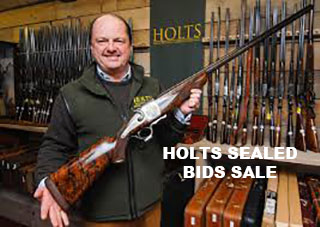Some of this year’s work has got me musing on the way many people behave when they get involved in old guns. For some reason, a lot of owners think they have an automatic right to get their money back or make a profit on a gun purchase. This may have been fuelled by the strong rises in prices that well-bought guns experienced in the 1990’s and early 2000’s.
However, guns, like any commodity, are prone to market fluctuations and right now they are depressed. Those demanding profits on guns bought at the top of the market are getting disappointed and frustrated, especially if they bought without doing their homework. Here are some points that those dabbling in the market would do well to consider:
When you bring your gun to a dealer, don’t expect him to pay you the full market retail price you paid, plus profit. Where is he going to make his margin? When you sell your car to a dealer, he won’t give you the price he puts on the forecourt ticket: neither should your gun dealer. Also, the ‘Give me what I need and make what you want on top’ attitude is no good if you ‘need’ full market retail value. I hear it all the time.
I was recently offered a pair of nice, early Holland & Holland ‘Royal’ side-locks. The buyer wanted £26,000 from me. The guns would have sold for £22,000 and I would have given him £20,000. He would not budge as he would ‘lose money’. Well, nobody is owed a profit, the market is what it is.
If you bought a gun in an auction, then paid a professional to restore it at full price, you won’t make killing when you try to sell it: especially to a dealer. You will already have paid the auctioneer’s profit and the VAT and the gunsmith’s time at retail price. This will take a few years to inflate away, assuming inflation is the state of the market. I recently disappointed a chap who made along journey with a nineteenth century back-lock gun expecting me to pay him about £5,000. I pulled out a close to identical one, but better, that we had just paid £2,000 for in auction and that had not been re-stocked with a piece of kitchen cabinet!
Some of the over-valued guns I see are as a result buyers going into the market and essentially playing poker without a full deck of cards. It is surprising how many people buy guns without knowing either the bore size or the wall thickness. They’ll say; ‘The bores are so clean they look like they have never been shot’. Of course, lapped bores look just like that to the amateur eye. They will look at the muzzles and take visible thickness there as an indication of overall wall thickness, which it is not. Without a good tool for measuring the chamber length, the bore size and the wall thickness, you should not be buying old guns, unless you like surprises.
Some months ago I followed up a telephone conversation, a gentleman had a collection of hammer guns to sell. He had accumulated them from friends and acquaintances over the years and they sounded interesting. Approaching retirement, he had decided it was time to cash-in, no doubt anticipating a hefty windfall. The list of names was impressive: Boss, Purdey, Lancaster, Atkin etc. However, the guns had been bought ‘informally’ from now defunct local dealers, or in pubs after shoots. When the bore and wall gauges started to tell the story in thousandths of an inch, the value of the guns plummeted from thousands to hundreds of pounds.
Another chap invited me to value a pair of best English guns; rare 16-bore Boss side-locks. Walls were 20 thou’ and there was two or three thou’ of margin in the bores before re-proof was necessary. Un-cased and in need of a few pounds refurbishment spent to bring them up to standard, I valued them a £20,000 - £22,000. The owner looked bemused. He had taken them some years previously as insurance against a loan. The debt was not honoured and he got to keep the guns. So what was the problem? The debt was to the tune of £85,000!
I have even had people buy guns unseen at Holt’s in the Sealed Bids auction and then try to sell them to me at twice what they paid, totally unaware of the state of the walls or bores and somehow thinking they were going to be able to operate in this way and ‘out-smart the dealers’.
For clarity, I would advise enthusiasts to invest the £700 necessary to buy a decent wall gauge and the £300 that a bore gauge will cost. They are invaluable tools that will pay for themselves. Of course, they need to be set correctly.
You can use a set of motor-trade gap-setting blades - they are supplied in graduated thicknesses for setting the timing on older motorcycles and cars and cost just a few pounds. This will show if your wall gauge is actually measuring 20 thou’ when the dial reads 20 thou’.
For bore gauges, there will be a set of rings set at standard reference sizes, like .729” so you can set the gauge there as a starting point and then measure increments up or down in thousandths of an inch. For shotguns, the crucial measurement is taken at nine inches in from the breech. These are also useful for getting accurate choke readings - choke is the difference between the bore and the muzzle diameter, in ‘points of choke’, one thousandth of an inch being one point of choke. So-called ‘choke gauges’ are a waste of money, as they only consider the muzzle diameter.
Pay attention to the original proof stamp, as not all guns were made at nominal gauge sizes. For example, a lot of 12-bores (nominal .729”) were made at .719” and will be stamped 13/1, or at .740” (stamped 12/1) or even more extreme at either end of the scale. Some nominal 12-bores were actually 14-bore when new. If you don’t start at the right point, you won’t make the right calculations about proof status. If working in Imperial figures, note that, under metric proof stamps, the rules for a gun remaining ‘in proof’ reduce to eight thou’; not the ten thou’ allowed under the old, Imperial proof marks.
Buyers beware, be diligent and arm yourselves with the right information before buying a gun. Beg or borrow the right tools, or take the gun to someone who has them, before handing over pound notes. I don’t want to be writing about you a few years from now!
Published by Vintage Guns Ltd on (modified )




